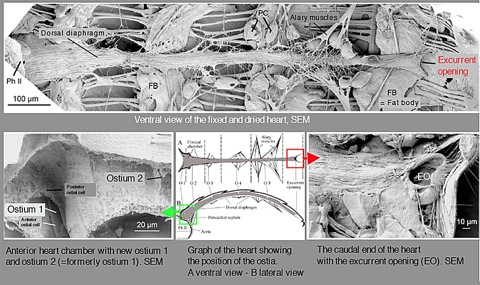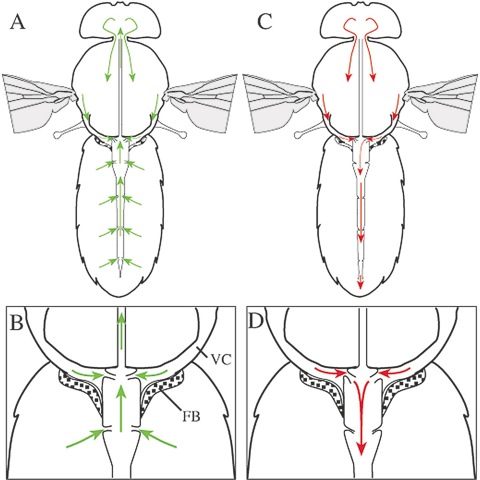Wasserthal, L.T. (2007): Drosophila flies combine periodic heartbeat reversal with a circulation in the anterior body mediated by a newly discovered anterior pair of ostial valves and „venous“ channels. J. Exp. Biol. 210, 3707-3719.
Heartbeat activity in tethered adult drosophilids was recorded using a linear optosensor chip and an IR-light beam. Recording from two to five sensor elements within 250 mum along the anterior heart, it was possible to analyze periodic reversals. In intact Drosophila melanogaster and D. hydei, longer anterograde pulse periods with lower pulse rates generally alternated with shorter retrograde pulse periods having higher pulse rates. These differences are dependent on heart anatomy: a newly discovered first pair of ostia is connected to bilateral thoraco-abdominal hemolymph channels. These channels are part of a venous space separated from the abdominal hemocoel by a septum, consisting of a metanotal ridge and the pericardial diaphragm lined by a special form of fat body. The channels are sealed, and their lumen is possibly controlled by the metathoracic tergo-pleural muscle. During retrograde pulses, the heart chamber works like a suction pump, aspiring hemolymph through the first ostia from the venous channels and discharging it through a newly described caudal opening. During forward beating, the anterior chamber receives hemolymph via all inflow ostia from the entire heart and drives it like a pressure pump through the narrow aorta. Also, during forward pulses, a lateral circulation occurs in the thorax as a result of the venous supply. Inhibition of abdominal mobility leads to an irregular heart rate, with pulse-wise alternating heartbeat reversals. The possible involvement of slow abdominal movements in heartbeat periodicity is discussed. The heartbeat periods are superimposed with intermittent bouts of abdominal pumping movements.
Structure of the abdominal dorsal vessel analyzed on the basis of light- and scanning electron microscopy
During forward beating (A, B), "blood" enters through all heart ostia maintaining a circulation in the thorax. During reverse beating (C, D), "blood" enters only through the first - hithertoo unknown - ostia and leaves through the caudal opening. VC = venous channel, FB = septum of fat body.

